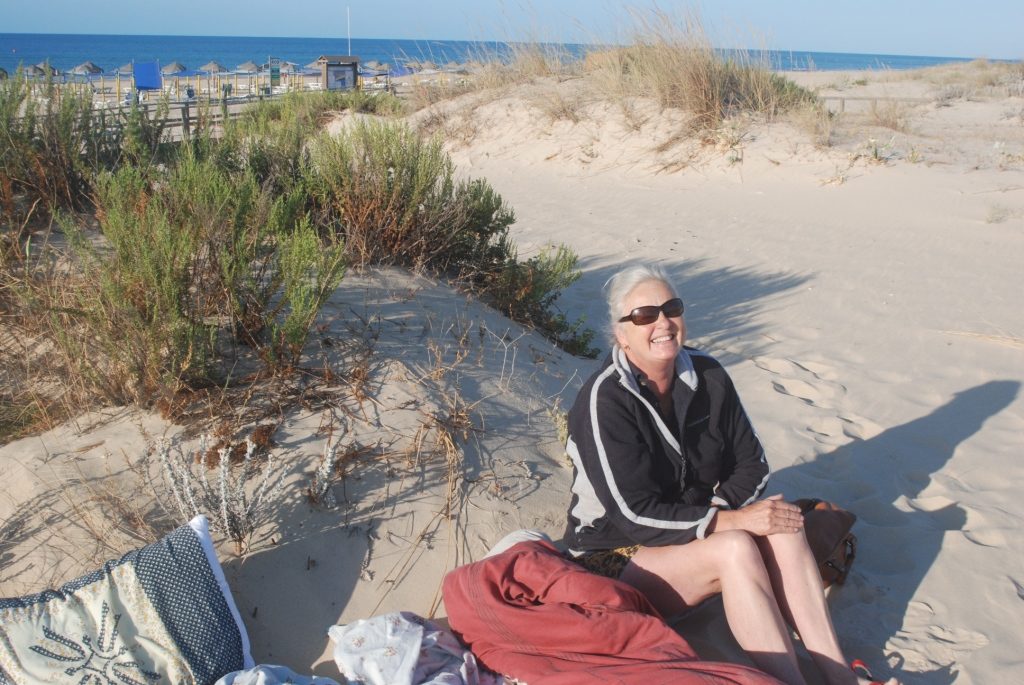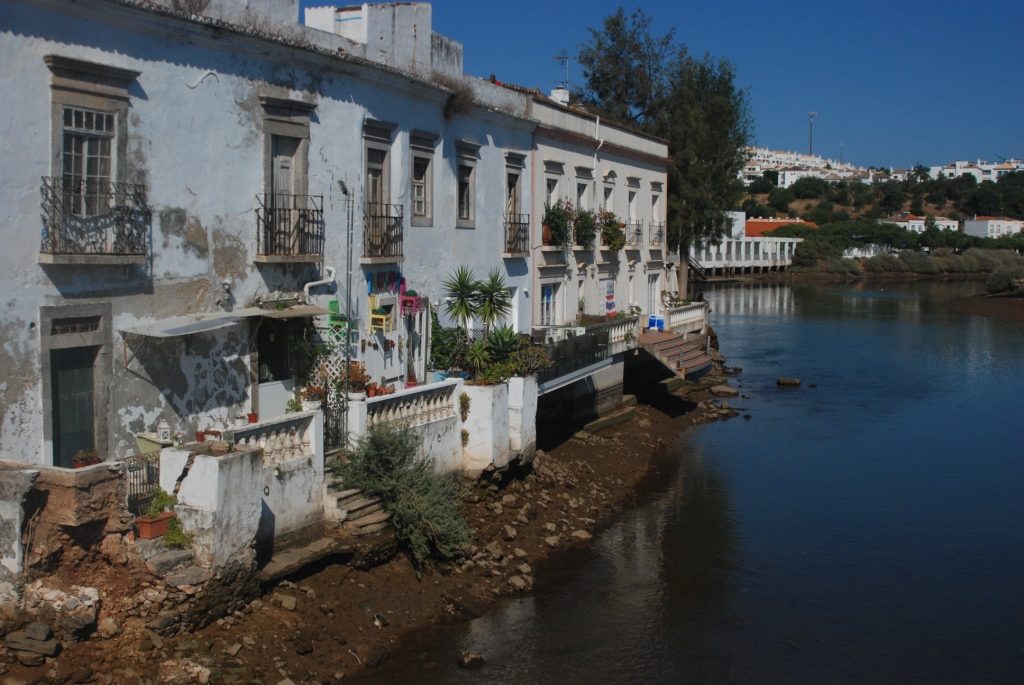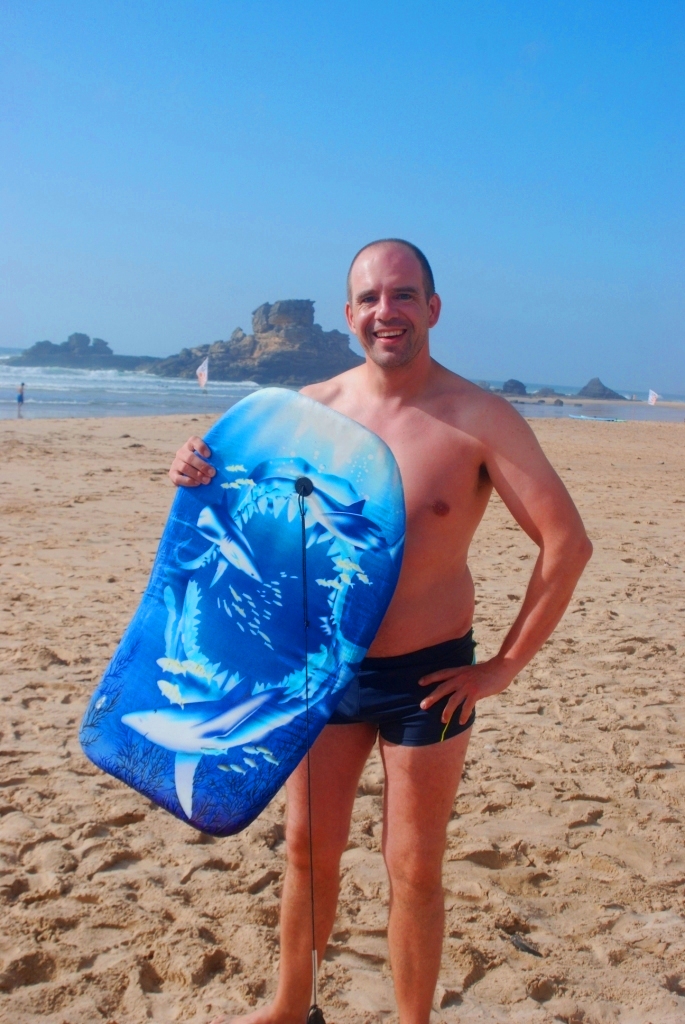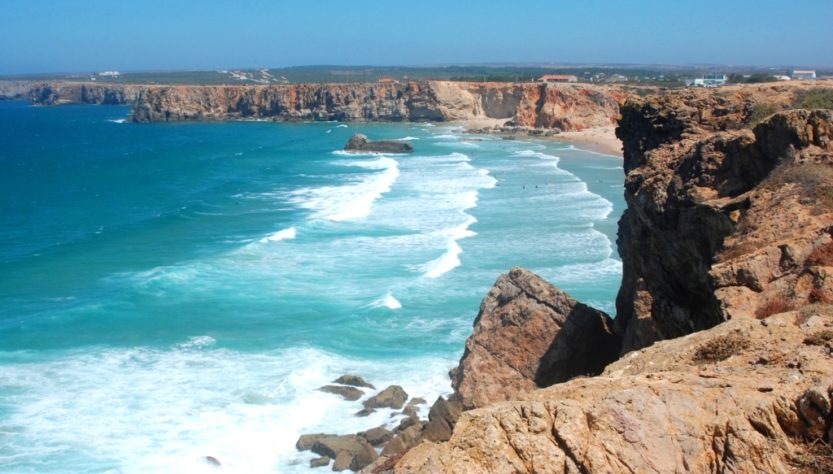The Mission
I heard my sister was coming to Portugal and had a spare week. We don’t get to meet up that often, so we decided to get together half way between my home in Granada, Spain and my sister’s arrival point in Lisbon.
A couple of days later, after 6 hours of bus travel and changing, I arrived at the town of Huelva and was welcomed by a big hug and my sister’s barely up to the job banger. A few minutes later the car dutifully started and we were burning down the highway towards the border, counting stork’s nests and checking out the chick’s experiments at flying under the watchful eyes of their parents.
Just before the border we decided to take a pit stop at the town of Ayamonte. In part this was to make sure my sister’s long time partner got a long desired refill of Spanish cigars and Soberano (the local brandy). The other part was we just desperately needed a drink, something to eat and a bit of time out from burning the tarmac.
I hadn’t read much remarkable about Ayamonte, so without any great expectations to weigh me down, I was pleasantly surprised. The drive off the highway passed lovely expanses of wetlands, bordering the protected area of Marismas de Isla Christina. The town itself was surprisingly colourful and laid back, sitting around a small marina and overlooking the Guadiana River with some nice vistas. There are plenty of little streets to explore and an open, easy-going small town feel.
Onwards and westwards! We climbed back into the Batmobile and headed across the huge, impressive suspension bridge crossing the Guardiana. There were some great views crossing the bridge, out over the river, and combined with the modern triangular wires of the suspension bridge above it’s a suitably dramatic entry into another country. By this time it was getting late and both Jane and me wanted to find a place to chill and hole-up for the night. So it was either going to be a campsite or roughing it.

Sis suggested the beach near the town of Alagoa was beautiful, and, apparently it wasn’t particularly built up. Jane had been along this part of the coast a few years before, when she was living on her boat, so, in the absence of other info, we went for Alagoa.
‘Sounds good – let’s check it out!’ I confirmed.
I desperately wanted a swim….I was feeling that kind of uncomfortable sweatiness you get from being on the road most of day, oscillating in and out of the sun and stuffy air-conditioned environments. The town of Alagoa was low-key but nothing to write home about. The beach however was spectacular, sheltered from the town by white powder sand dunes and interlaced with flowers and herbs. It was a self contained eco-system and was lovely. In the evening light kids and families played on a beach that seemingly stretched endlessly in both directions. I wasted no time, diving into the refreshing water that was just full-on gorgeous!
A night under the stars
We hadn’t found a campsite anywhere near, so our pressing problem as night closed in and people left the beaches was where to sleep. We decided to risk the super budget option – park the car and spend a night under the roof of the stars. Zero Euros per night. Quite a bargain. Perfect, or so I thought!
We spent an hour or so having a drink in a ‘sporty bar’ showing non-stop coverage of some world surfing tournament. I found it difficult to look away from that – wanting to have a go myself. I’d get my chance soon enough, although perhaps not in the way of the pros!

Come twilight we took a couple of duvets and pillows each and made our way furtively from the car park, across a wooden walkway, past the dunes and on to the beach, now deserted apart from the gentle sonorous rhythms of the waves. We initially parked ourselves in the middle of the beach, on a couple of sun loungers that were left unused, conveniently, for the night. The wind was surprisingly cool – so I made the most of the duvet. Packing my valuables in bag I placed them strategically under the sun lounger for security – minimal though that was! Although we could hear some intensely loud and shite karaoke coming from a resort far down the beach it felt wonderfully isolated. I gazed at the stars in the sky, thinking of what our ancestors would have seen in their shapes, watching falling stars tear through the silky blackness above. Everything felt good – until a pair of guys decided to turn up on the beach and smoke some kind of weed – or maybe cook something stronger. Whatever – it involved some fire. They obviously didn’t know we were there and we didn’t want any trouble, so we hunched down and waited for them to go, but now with senses very much on the alert.
After half an hour or so they buggered off, but now we felt less secure, ‘I think this spot is bit insecure, exposed’ stated my sister.
‘I agree – best head behind those dunes – sleep somewhere there. No one will ever find us there, not unless they’re specifically looking for us!’ So we wondered up the beach and stashed ourselves behind a comfortable looking dune, feeling more secure now that we were ‘hidden’. The powder like sand was very comfy – much better than many hard earthed campgrounds I’d stayed in, but the strong wind gave me a free sand exfoliation service at ground level. I realised also why mammals have eyelashes! As the night went on it got seriously cold and I dug myself into the sand and had to cover my face to stop myself from shivering – a polar opposite from the baking 42°C heat in Granada, a few hundred kilometres away in Andalucía. A few times I questioned whether I could carry on, or would retreat to the car and sleep it out in the shelter of the front seat. But exhaustion prevailed and I slept…in fits and starts. And sleeping with only stars for a roof is amazing.
Dawn’s first rays amidst the flowers, herbs and dunes brought a little heat and light back to our camping spot. We laughed at our experiences of the night and grabbed our stuff. We were totally caked in salt and sand. An amazing adventure! I’m a bit of an ecologist and environmentalist – and so is Jane – so making sure we’d left no trace of our presence behind we headed back to the car park, hoping that someone hadn’t run of with the mobile during the night. It wasn’t worth much anyway!
Tavira
Luckily the car was still were we left it, so we started her up and burned down to the lovely old river town of Tavira. It was still early in the morning, perhaps around 9, when we decamped in the centre. Tavira is a lovely town: low rise, low key, sitting in the mouth of a river, presided over by an old bridge with lush gardens, terrapin filled pools and houses, painted bright colours or covered in artistic tiles. We staggered into a friendly cafe that overlooked a point where tourists and locals headed off on ferries for a day on Isla Tavira. Isla Tavira is a huge 20 kilometre long sandbar of a beach, seemingly within touching distance of the town but nevertheless completely cut off from the mainland by a thin channel. Dolphin watching tours were also being offered.

Speaking in a combo of Spanish & English with an improvised Portuguese accent we made ourselves understood and soon I was treating myself to a coffee, orange juice and toastada. Then decided another was in order after our money saving night on the beach – I felt I deserved it!
Tavira’s a lovely place, somewhere I’ve marked for return, plus I’d love to check out the island as well. Based on initial observations, for sheer sun, space and sand, it looked difficult to beat. Tavira also seemed to represent a very Portuguese vibe: mellow, easy going, but somehow more restrained and conservative than on the Spanish side of the coast.
Sis suggested we should make for Faro, the regions transport hub and historic capital. Into the car again, headin’ out on the highway, the wind in our exceedingly salty hair! Burning along the coastal road we soon approached Faro. It was an approach that was highlighted by the constant presence of planes in the sky above – Easyjet, Ryanair, Alitalia – all lining up to arrive in Faro. Looking at the amount of air traffic, I couldn’t imagine anything else apart from tourist hell.
We stopped at a supermarket to get a little lunch and headed through the extensive, highly built up new town to the surprisingly tranquil old town, parking the car near the train station and loping into the centre, built of elegant colourful buildings, bars and restaurants set around a marina. Sure, it was a touristy spot with foreign languages everywhere and a major concert stage up and ready to go for some gig or other, but it was a much mellower spot than I’d imagined. Maybe most people just land in Faro and then zoom straight off to heady package resorts along the coast. I don’t know!
Then there’s Faro’s ancient walled Citadel – a little architectural time capsule of cobbled streets and plaza’s overlooking the port, the sea and lots of islands. Over lording over the citadel, in the spring and summer, huge numbers of storks nest and tranquilly glide above the old town. Their natural elegance contrasting sharply against the next ‘Iron Bird’ zooming over every couple of minutes as they make their final descent to Faro airport.
Anyway Janey had said the islands off shore were pretty special, with Isla Culatra being like a little Caribbean Island. I was pretty intrigued to see a Caribbean vibe island on the Algarve, so we managed to get the last ferry (around 15:00 ish) to the island. It would be a fleeting visit, but what the hell! Faro is in another Delta and the ferry ride out requires careful navigation past shallow channels, mud flats revealed at low tide and sandbars everywhere. It’s a wading birds paradise, with always a few crabs, worms and isolated fish to catch. Wildlife and bird fans take note and bring your binoculars!
A Desert Island
Leaving the estuary and views of walled town behind we headed into a wide open sound, almost entirely surrounded by islands and islets of various sizes and habitability. Culatra is one of biggest. Stepping off the ferry onto the island, with its cute little collection of cafes and bars – most just one floor shacks really, I could see where Sis got here idea of the ‘Caribbean’ vibe. It seemed like a sandy version of Bonaire, without the rockiness or the palm trees of that island, but with lots of sand. I was anxious to explore the island and we set out on a walkway leading to a beach on the far side – we never made it though. Jane said she remembered a lagoon where a bunch of Catamaran owners has basically set up shop, turning their boats into permanent ‘hippy style’ floating homes. We wondered ‘off-trail’ over an area of brush and low scrub, coming very close to a pair of huge storks foraging in the heat of day for lunch snacks. They seemed remarkably confident and comfortable with human presence.
We moved on, reaching the top of a little sand dune and looked down on Jane’s hidden lagoon. It was a lovely shallow bay, almost hemmed in from the sea, except for one thin channel at the far end. No catamaran’s though, the hippy community had a either moved on or been thrown out! Wealthier boat owner’s only, thanks! Plenty of bits of boats remained as clues; ropes, buoys – they lay scattered around the shore.
Time for a chill and a much needed swim – then we had to hustle to catch the last ferry back to the mainland or risk gettin’ stranded on the desert island for the night. I wouldn’t say the island was exactly Caribbean, but it was definitely funky and worthy of exploration. In serious need of a fresh water shower and bathrooms we headed for the well equipped and very family orientated Parque de Campismo e Caravanismo de Olhao. Many people looked like they’d set up shop here for the whole summer. We set up the tent and experienced the luxury of bathrooms, running water and a hot shower for the day. Feeling salt & sand free was a bonus and a half. Camp sites are pretty cheap and good value in Spain and Portugal – generally coming in at around € 20 per night for 2 people and a tent. Pretty good for people wanting to cover maximum ground on a minimal budget!
In many ways this bit of Portugal’s coast was similar to Spain’s around Donana National Park: low lying, sand dune rich beaches, backed by wetlands, scrub and Spanish Pine. It’s a beautiful area, but I wanted to see something different. I wanted the other side of the Algarve, the high cliffs and rugged coastline around Cabo San Vincent, the south western tip were Portugal’s Algarve ends, suddenly turning north towards Lisbon.
Wild cliffs and Wild Waves
We took the tent down and hit the road, heading straight for the Cape. Gradually the constant wind started to increase, the temperatures dropped a little and ground rose up, becoming hillier. Cabo San Vincent is an isolated spot, a windswept peninsular of low green scrub, battered and bent by the prevailing winds year round. It’s surrounded by dramatic vertical cliffs on all sides. The lighthouse and fort and far end of the peninsular is worth checking out for the magnificent vertigo inducing views into the roaring sea far below, as much as anything else. Seagulls nest on remote spots everywhere, waiting for scraps from day trippers or the ocean, soaring on powerful winds. If you’re wearing a hat, hold onto it or it’s likely to disappear over the edge of the cliff into the abyss far below! It’s a bracing experience, the first time I’ve felt I needed to wear a jacket in Iberia this summer (near sea level that is!).
It’s a lot more of a funky ‘sporty’ vibe here than to the east – youthful and energetic – the kind of place I love. There are fantastic hiking routes along the spectacular coast, across the peninsular. The region offers wonderful surfing on the exposed Atlantic coast, with specially adapted ‘surf n’ cycle’ bikes available everywhere. You can peddle and stow your board on a specially made holder on your bike – it looks a little like a bike with a heat seeking missile on the side! On the more protected south coast diving & snorkelling abound and the charming little port of Sagres offers a variety whale and dolphin watching opportunities with what seems to a be a strong conservation ethic being widely promoted and followed.
We spotted a campsite – Camping & Bungalows Orbitur Sagres, in a beautiful sheltered patch of woodland. It was a great spot, with a friendly crowd of quirky travellers adding to the ambiance. There was even a camp & surf school set up there, a great idea!
We set up the tent and went to check out one of the awesome surf beaches on the west coast. At the bottom of long, remote, forested gully lies Praia de Castelejo – it feels wonderfully isolated, even though it’s popular with surfers in summer. The beach is jammed in between high cliffs on each side. The perfect sand and the setting is hard to beat! Surf schools are common and for the hard core surfers it wasn’t hard to see the attraction: 3 metre walls and tubes seemed the norm in the intimidating waves ‘out back’.

Having just had a hip replacement I wasn’t going to go for the full ‘Point Break’ just yet, but I wanted to at least play around in the surf. I considered renting a body board from the school on the beach, then my sister spotted a semi-broken body board consigned to the scrap heap sticking out of a bin. I decided to recycle it for my own use – it wasn’t quite broken enough to be useless. Play time was on! Time for a bit of amateur body boarding!
I rushed into the cool water, a little apprehensive at first due to the strong pull of the current to the South, but as soon as I dived down and rushed with the waves a few times – zooming towards the shore with visceral energy of the sea, oh my! All I could think of was catching the next wave to feel the Atlantic’s power zip me along the surface. It was a total blast! No future, no past, just the next wave in shore. Just wild, out-there fun! Plus the spectacular setting only enhanced the wonder of the scene! I pulled myself away from the sea a few hours later in awe, a happy man! ‘100% percent pure adrenaline’ as Patrick Swayze would say.
After a couple of games of pool and some drinks at the camp site I slept soundly that night!
Packing up at the campsite the next morning I felt a little sad that our short holiday was coming to an end. Time and money were running out and the plan was that I catch a bus back from Faro to Sevilla and then to Granada the next day. Nevertheless the was still time to grab a mask and snorkel and check out the marine life at the lovely Praia de Beliche on the south coast of the peninsular – not far from the campsite. Hiking down the spectacular cliffs I delved into the sea in this much more sheltered spot. I had more than a little shock to find the water here was the coldest I’d encountered along the coast. It felt initially like a cold burn! Although the water was pretty stirred up there were plenty of big fish, starfish and anemones to grab my interest. Jane took soooooo long to convince herself to dive in to the waters she actually ended up getting a good sunburn! The full lobster!
Then the long drive back to Faro began, stopping once at the pleasant port and beach of Alvor on route for a final swim. By the time we made it back to Faro, the sun had set – it was night – too late to camp and we didn’t have the cash to fork out for a room. We crashed out in the car.
The next morning I gave my sister a hug and got on the bus to Seville and she took off for Lisbon. On the bus I dreamed of body boarding in Cabo San Vincente, lazy mornings overlooking the river in Tavira and Portuguese Caribbean style Islands. It had been a wild ride over 4 days. It felt longer, stuffed to the max with experiences – and it was part of the world which I’d like to return to again…..
